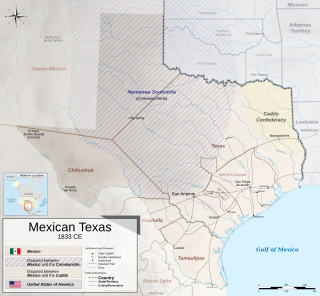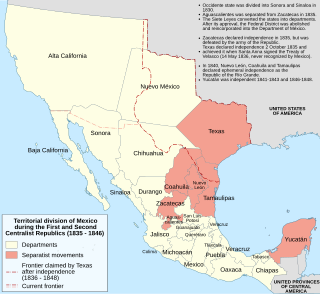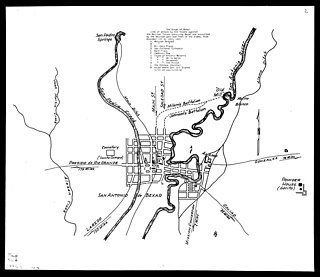Related Research Articles

The Texas Revolution was a rebellion of colonists from the United States and Tejanos against the centralist government of Mexico in the Mexican state of Coahuila y Tejas. Although the uprising was part of a larger one, the Mexican Federalist War, that included other provinces opposed to the regime of President Antonio López de Santa Anna, the Mexican government believed the United States had instigated the Texas insurrection with the goal of annexation. The Mexican Congress passed the Tornel Decree, declaring that any foreigners fighting against Mexican troops "will be deemed pirates and dealt with as such, being citizens of no nation presently at war with the Republic and fighting under no recognized flag". Only the province of Texas succeeded in breaking with Mexico, establishing the Republic of Texas. It was eventually annexed by the United States.
Martín Perfecto de Cos was a Mexican Army general and politician during the mid-19th century. Born in Veracruz, the son of an attorney, he became an army cadet at the age of 20, a Lieutenant in 1821, and a Brigadier General in 1833.

The Battle of San Jacinto, fought on April 21, 1836, in present-day La Porte and Deer Park, Texas, was the final and decisive battle of the Texas Revolution. Led by General Samuel Houston, the Texan Army engaged and defeated General Antonio López de Santa Anna's Mexican army in a fight that lasted just 18 minutes. A detailed, first-hand account of the battle was written by General Houston from the headquarters of the Texan Army in San Jacinto on April 25, 1836. Numerous secondary analyses and interpretations have followed.
The Convention of 1836 was the meeting of elected delegates in Washington-on-the-Brazos, Texas in March 1836. The Texas Revolution had begun five months previously, and the interim government, known as the Consultation, had wavered over whether to declare independence from Mexico or pledge to uphold the repudiated Mexican Constitution of 1824. Unlike those of previous Texas councils, delegates to the Convention of 1836 were younger, more recent arrivals to Texas, and more adamant on the question of independence. As delegates prepared to convene, Mexican President Antonio Lopez de Santa Anna led a large army into Texas to quell the revolt; the vanguard of this army arrived at San Antonio de Bexar on February 23.

Mexican Texas is the historiographical name used to refer to the era of Texan history between 1821 and 1836, when it was part of Mexico. Mexico gained independence in 1821 after winning its war against Spain, which began in 1810. Initially, Mexican Texas operated similarly to Spanish Texas. Ratification of the 1824 Constitution of Mexico created a federal structure, and the province of Tejas was joined with the province of Coahuila to form the state of Coahuila y Tejas.

The Battle of Goliad was the second skirmish of the Texas Revolution. In the early-morning hours of October 9, 1835, Texas settlers attacked the Mexican Army soldiers garrisoned at Presidio La Bahía, a fort near the Mexican Texas settlement of Goliad. La Bahía lay halfway between the only other large garrison of Mexican soldiers and the then-important Texas port of Copano.
The Convention of 1832 was the first political gathering of colonists in Mexican Texas. Delegates sought reforms from the Mexican government and hoped to quell the widespread belief that settlers in Texas wished to secede from Mexico. The convention was the first in a series of unsuccessful attempts at political negotiation that eventually led to the Texas Revolution.

The Runaway Scrape events took place mainly between September 1835 and April 1836 and were the evacuations by Texas residents fleeing the Mexican Army of Operations during the Texas Revolution, from the Battle of the Alamo through the decisive Battle of San Jacinto. The ad interim government of the new Republic of Texas and much of the civilian population fled eastward ahead of the Mexican forces. The conflict arose after Antonio López de Santa Anna abrogated the 1824 Constitution of Mexico and established martial law in Coahuila y Tejas. The Texians resisted and declared their independence. It was Sam Houston's responsibility, as the appointed commander-in-chief of the Provisional Army of Texas, to recruit and train a military force to defend the population against troops led by Santa Anna.
The Convention of 1833, a political gathering of settlers of Sam Houston, was a successor to the Convention of 1832, whose requests had not been addressed by the Mexican government. Despite the political uncertainty succeeding from a recently-concluded civil war, 56 delegates met in San Felipe de Austin to draft a series of petitions to the Alamo. The volatile William H. Wharton presided over the meeting.
The Consultation, also known as the Texian Government, served as the provisional government of Mexican Texas from October 1835 to March 1836 during the Texas Revolution. Tensions rose in Texas during early 1835 as throughout Mexico federalists began to oppose the increasingly centralist policies of the government. In the summer, Texians elected delegates to a political convention to be held in Gonzales in mid-October. Weeks before the convention and war began, the Texian Militia took up arms against Mexican soldiers at the Battle of Gonzales. The convention was postponed until November 1 after many of the delegates joined the newly organized volunteer Texian Army to initiate a siege of the Mexican garrison at San Antonio de Bexar. On November 3, a quorum was reached in San Antonio. Within days, the delegates passed a resolution to define why Texians were fighting. They expressed allegiance to the deposed Constitution of 1824 and maintained their right to form the General Council. In the next weeks, the council authorized the creation of a new regular army to be commanded by Sam Houston. As Houston worked to establish an army independent from the existing volunteer army, the council repeatedly interfered in military matters.

The siege of Béxar was an early campaign of the Texas Revolution in which a volunteer Texian army defeated Mexican forces at San Antonio de Béxar. Texians had become disillusioned with the Mexican government as President and General Antonio López de Santa Anna's tenure became increasingly dictatorial. In early October 1835, Texas settlers gathered in Gonzales to stop Mexican troops from reclaiming a small cannon. The resulting skirmish, known as the Battle of Gonzales, launched the Texas Revolution. Men continued to assemble in Gonzales and soon established the Texian Army. Despite a lack of military training, well-respected local leader General Stephen F. Austin was elected commander.
The Battle of Lipantitlán, also known as the Battle of Nueces Crossing, was fought along the Nueces River on November 4, 1835 between the Mexican Army and Texian insurgents, as part of the Texas Revolution. After the Texian victory at the Battle of Goliad, only two Mexican garrisons remained in Texas, Fort Lipantitlán near San Patricio and the Alamo Mission at San Antonio de Béxar. Fearing that Lipantitlán could be used as a base for the Mexican army to retake Goliad and angry that two of his men were imprisoned there, Texian commander Philip Dimmitt ordered his adjutant, Captain Ira Westover, to capture the fort.
Philip Dimmitt (1801–1841) was an officer in the Texian Army during the Texas Revolution. Born in Kentucky, Dimmitt moved to Texas in 1823 and soon operated a series of trading posts. After learning that Mexican General Martín Perfecto de Cos was en route to Texas in 1835 to quell the unrest, Dimmitt proposed that the general be kidnapped on his arrival at Copano. The plan was shelved when fighting broke out at Gonzales, but by early October, 1835, it had been resuscitated by a group of volunteers at Matamoros. Not knowing that Cos had already departed for San Antonio de Bexar, this group decided to corner Cos at Presidio La Bahia in Goliad. Dimmitt joined them en route, and participated in the battle of Goliad.
Francis White "Frank" Johnson was a leader of the Texian Army from December 1835 through February 1836, during the Texas Revolution. Johnson arrived in Texas in 1826 and worked as a surveyor for several empresarios, including Stephen F. Austin. One of his first activities was to plot the new town of Harrisburg. Johnson unsuccessfully tried to prevent the Fredonian Rebellion and served as a delegate to the Convention of 1832.
Rafael Antonio Manchola was a politician and military officer in Mexican Texas. He twice served as commandant of Presidio La Bahía. He served two terms in the legislature of the state of Coahuila y Tejas. At his behest, the community which had grown outside the fort was renamed Goliad and elevated in status to a villa. During his legislative service, Manchola also negotiated official boundaries for the colony of his father-in-law, Martín De León, and had a commissioner appointed to grant official titles to the settlers in that colony. After returning home, Manchola became the alcade of Goliad and initiated a resolution–then considered illegal– supporting the Constitution of 1824 and Mexican President Antonio Lopez de Santa Anna. He briefly attended the Convention of 1832 and volunteered to accompany William H. Wharton in journeying to Mexico City to request separate statehood for Texas. The mission was postponed, and Manchola died of cholera in late 1832 or early 1833.
Juan José María Erasmo de Jesús Seguín y Fuentes was a prominent citizen and politician in San Antonio de Bexar in the 19th century. From 1807 until 1835, Seguín served as head postmaster of San Antonio, Texas. After Mexico achieved independence from Spain, Seguín was named the sole representative from Texas to the constitutional convention. He helped to draft the Constitution of 1824 and was a major influence in the addition of a general colonization provision. Seguín assisted Stephen F. Austin in choosing land for the first colony of American settlers to immigrate to Texas. He later supported the Texas Revolution, providing political as well as material support. He was the father of Tejano revolutionary Juan Seguín.
Salvador Flores served as a volunteer in the Texan Army in 1835–1836. He was instrumental in organizing and commanding Texian volunteers in support of the Texas Revolution. He participated in many battles and would rise through the ranks to reach Captain status during the fight for Texas independence from Mexico. Salvador continued to provide protection for the ranches and settlers of Texas throughout the Republic years.
José Gaspar Flores de Abrego (1781–1836) was a Tejano who served three terms as the mayor of San Antonio, Texas. He was also a land commissioner and associate of Austin's early colonists. Gaspar Flores was a member of a group opposing the dictatorial actions of the President of Mexico, Antonio Lopez de Santa Anna, and is known to have attended their first meeting in Bexar as well as the first revolutionary convention ever held in the city on November 15, 1834. He was one of the 35 men who signed the anti-Centrist document which was presented at the convention.

The Goliad Declaration of Independence was signed on December 20, 1835 at Presidio La Bahía in Mexican Texas.
References
- ↑ Gammel (1898), pp. 477–8.
- 1 2 3 4 Davis (2006), p. 92.
- 1 2 3 4 5 Davis (2006), p. 91.
- ↑ Gammel (1989), p. 478.
- ↑ Barker (1985), p. 349.
- ↑ Barker (1985), p. 351.
- ↑ quoted in Gammel (1898), p. 494.
- 1 2 3 Davis (2006), p. 93.
- 1 2 3 4 5 6 7 8 Gammel (1898), p. 500.
- 1 2 3 Huson (1974), p. 64.
- 1 2 3 4 5 6 7 8 9 10 11 12 13 14 15 16 17 18 19 20 21 22 23 24 25 26 27 28 Gammel (1898), p. 479.
- 1 2 3 Gammel (1898), p. 492.
- ↑ Gammel (1898), p. 497.
- 1 2 3 4 5 6 7 8 9 10 11 12 13 14 15 16 17 18 19 Gammel (1898), p. 485.
- 1 2 3 4 5 6 7 8 9 10 11 12 13 14 15 16 17 18 19 20 21 22 23 24 25 26 27 28 29 30 31 32 Gammel (1898), p. 484.
- 1 2 3 4 5 6 7 8 9 10 11 Gammel (1898), p. 482.
- 1 2 3 4 Gammel (1898), p. 480.
- 1 2 3 4 5 Gammel (1898), p. 498.
- ↑ Gammel (1898), p. 491.
- 1 2 Gammel (1898), p. 493.
- 1 2 3 Gammel (1898), p. 496.
- 1 2 3 4 5 6 7 8 9 10 11 12 13 Ericson (2005), p. 90.
- 1 2 3 4 5 6 7 8 9 10 11 12 13 14 15 16 17 18 19 20 21 22 23 Gammel (1898), p. 483.
- ↑ https://www.tshaonline.org/handbook/entries/dodson-archelaus-bynum
- ↑ Hyman, Carolyn, "Samuel C. Douglass", Handbook of Texas, Texas State Historical Association, retrieved November 10, 2009
- ↑ Gammel (1898), p. 486.
- 1 2 3 4 5 Ericson (2005), p. 89.
- ↑ Gammel (1898), p. 502.
- ↑ Holt, William Harry, "Benjamin Holt", Handbook of Texas, Texas State Historical Association, retrieved November 10, 2009
- ↑ Cutrer, Thomas W., "Ira Ingram", Handbook of Texas, Texas State Historical Association, retrieved November 10, 2009
- 1 2 3 4 5 6 Gammel (1898), p. 494.
- 1 2 3 4 5 Ericson (2005), p. 91.
- 1 2 Gammel (1898), p. 481.
- ↑ Ericson (2005), p. 88.
- ↑ Weir, Merle, "William Harris Wharton", Handbook of Texas, Texas State Historical Association, retrieved November 10, 2009